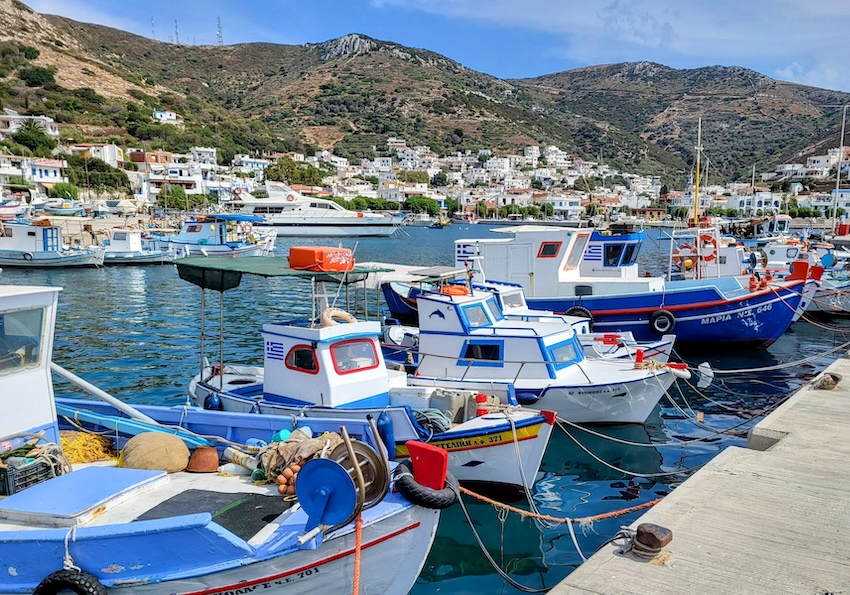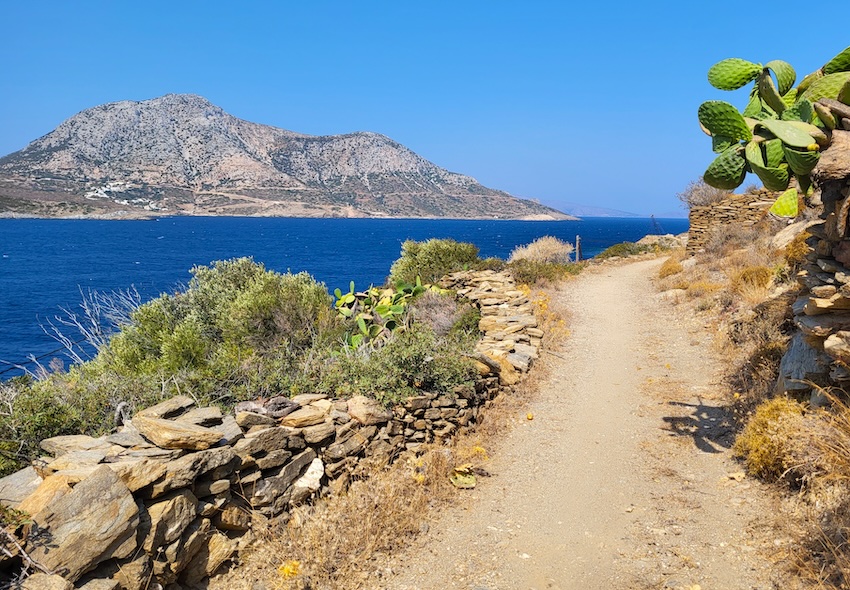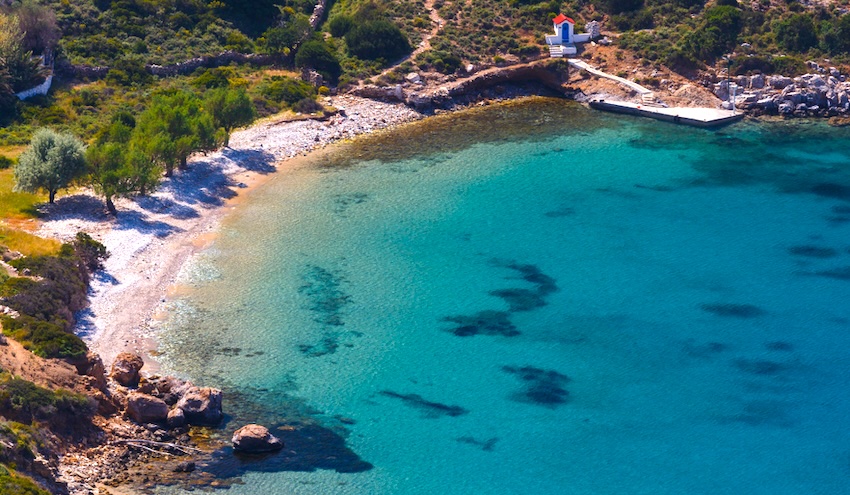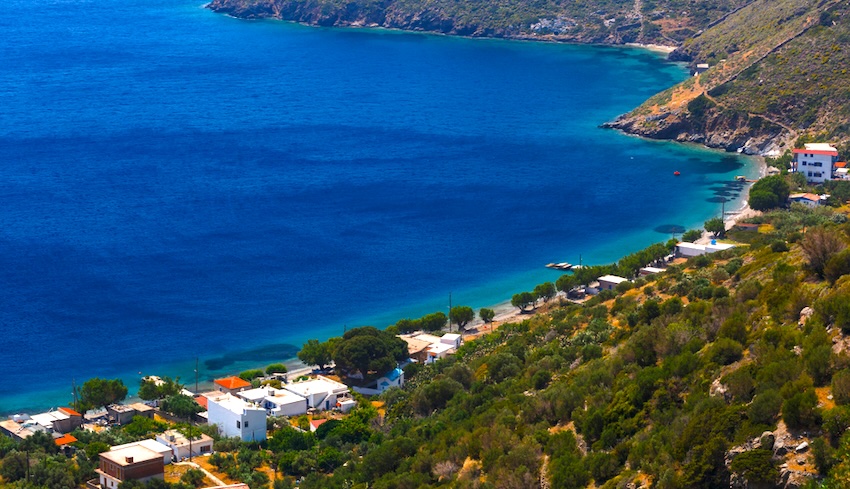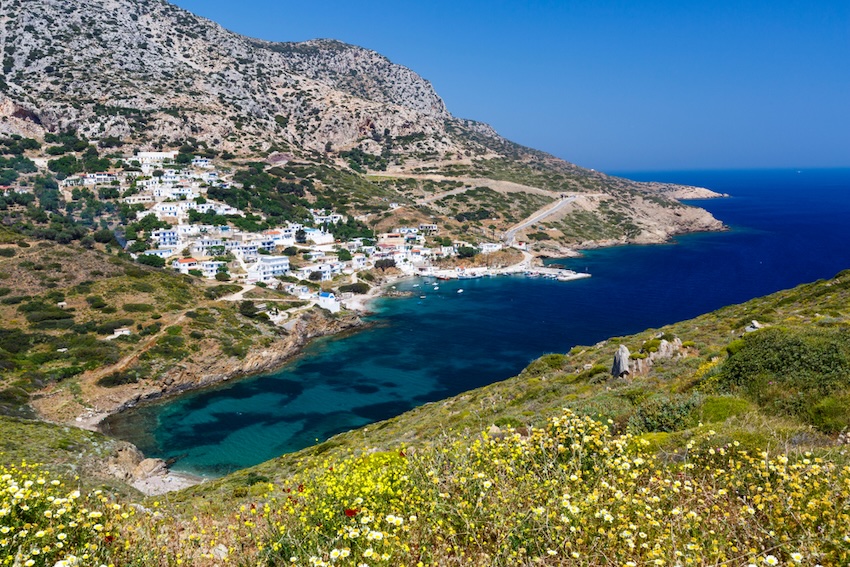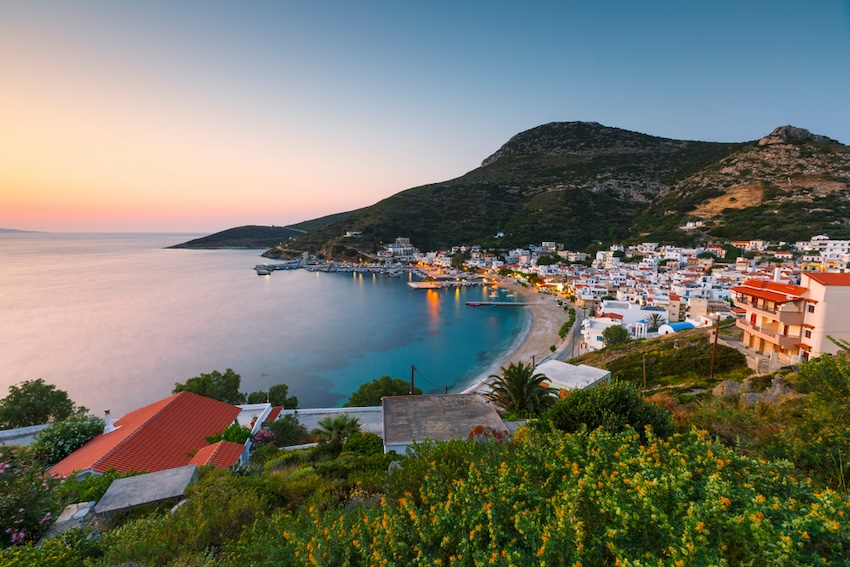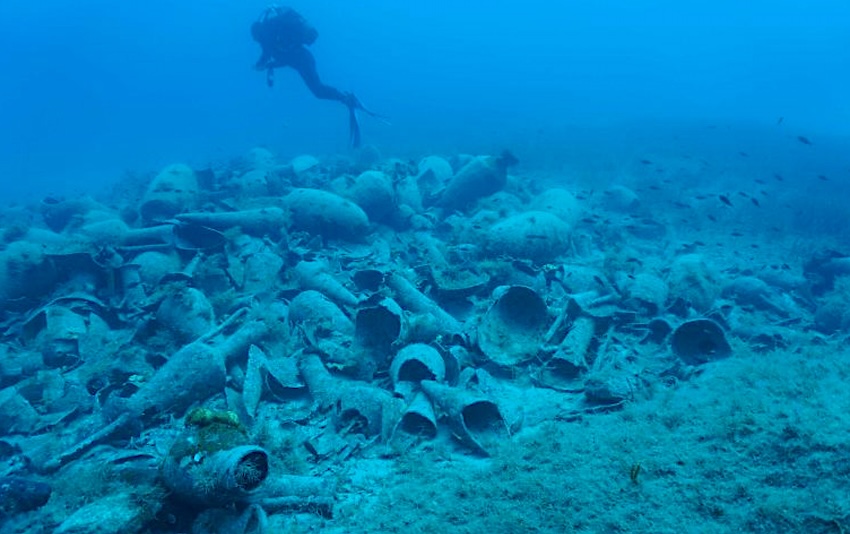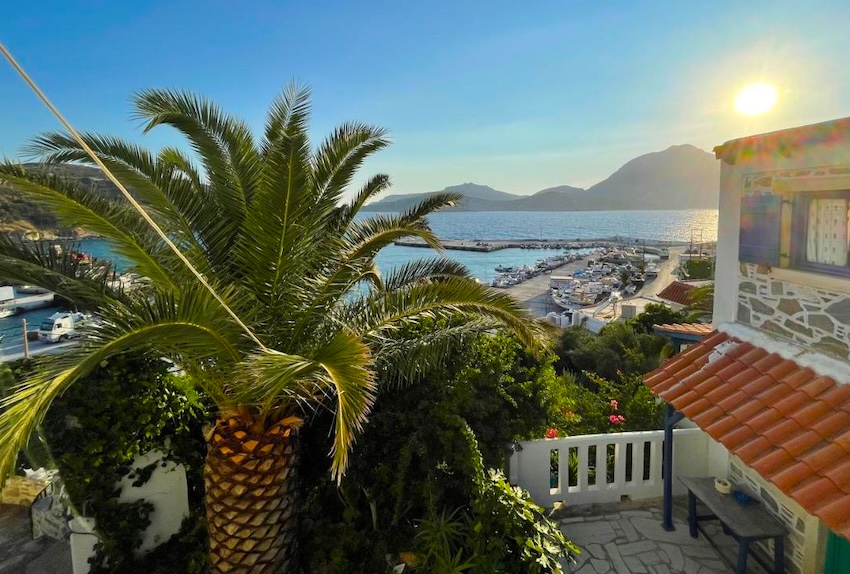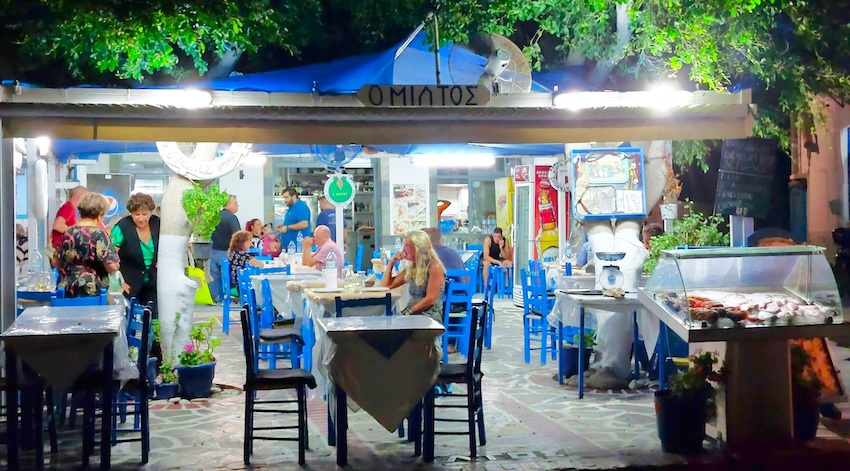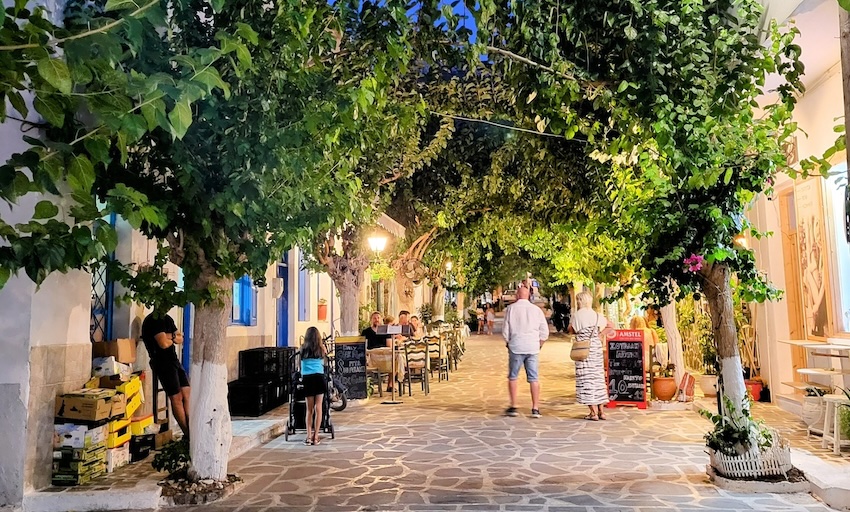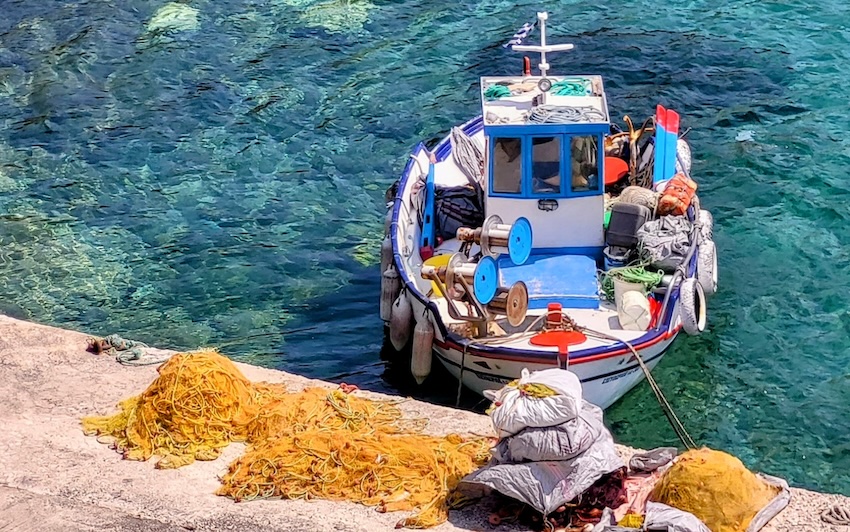
Fourni
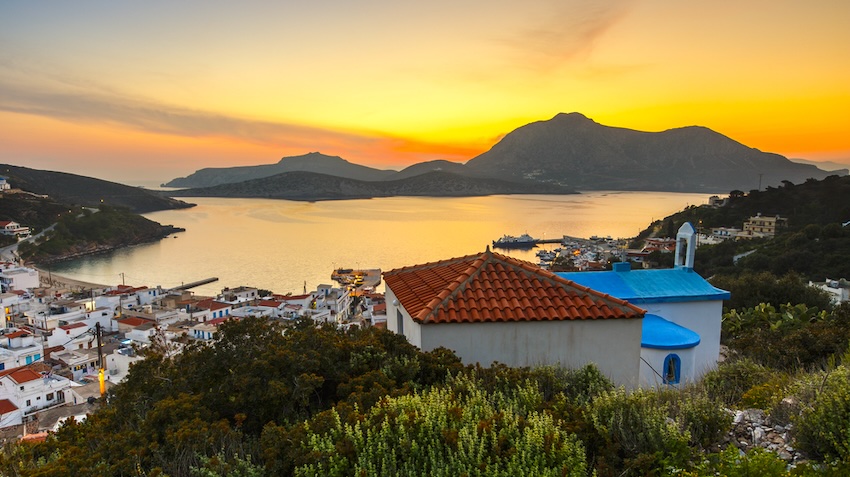
Fournoi Korseon: Shipwreck Centre of the World?Written by J Kathleen Thompson If you are looking for an island that seems blissfully unaware of any changes in the world or nip-n-tucks in the tourism industry since 1980, you will find it in Fournoi, the archipelago of 13 small islands between Ikaria and Samos in the Eastern Aegean. From the Blue Star ferry slip begging for space behind a tangle of weathered fishing boats to a harbourside road strewn with tavernas and pensions and calico cats, veteran travellers will recognize the pre-tourist-boom Greece immediately. Those times when arranging accommodation was a matter of either stepping off the ferry gangplank and onto the back of the first scooter in line, or navigating through quiet village streets until you find the pension with the keys left in the door for you. And waking the next day to the sharp glare of the Mediterranean sun and the promise of days adrift in an incandescent blue tethered only to a wild coastline, stark mountainsides and new friends gathered around a table in the village square. Welcome to Fourni in 2024.. |
|
|
The Port: Fourni TownWhile the wild beauty of Fourni will beckon, take time to get your bearings in the port in which you landed and the islands' hub, home to 90% of the island’s 1,300 residents. Hugging the harbour, a perfect asymmetry of white stone homes, balconies festooned with laundry and bougainvillea cascades down the hills to the village streets below. A procession of mulberry trees marks the main street of Fourni Town, with cafes and shops and bakeries peering through the trees' dense, dark green foliage on either side of the street. Tavernas cluster round the square at the top of mulberry lane, and at night, children, of all ages and with whatever mobility device they can muster, weave between the cenotaph and Roman sarcophagus and restaurant patrons, oblivious to their parents' calls and anything else that might curb the delirious freedom of a child's summer on a small Greek island. On the waterfront, restaurants jostle for business, with tanks of fresh lobster assuring prospective patrons that the island specialty – lobster spaghetti with lemon and oil – can be sampled within. But you know if you score a table in one of these restaurants, it's not going to be just about the lobster, it's going to be about being part of the scene. The infused-with-life summer's-night-on-a-Greek-island scene. |
|
|
Exploring the IslandWhen you learn that Fourni is also known as Fournoi Korseon due to the fact that its coastline's hidden bays and coves made it a haven for pirates in the day, you will be keen to get exploring. As there is no bus service on the island, transportation choices are limited to walking (with just the occasional trail), cycling (if you bring your own bike), scooters, cars or quads (all of which can be rented in Fourni Town). Hiring boats or cars for guided excursions are both possible; the ferry ticket office or Europa Rent-a-Car can provide further information on excursions and tours. |
|
|
|
You'll find that Fourni island is essentially a dyad of two peninsulas, and with your own wheels, its 31 square kilometres can be easily 'scanned' in a day. Along its southern peninsula lies the other main harbour and best catered beach on the island – Kampi - as well as numerous unserviced coves and beaches. One of those – Petrokopio – sits aside a marble quarry, its collection of intact columns and pedestals still looking ready to be shipped to the ancient city of Ephesus, once a great importer of Fourni marble. Other beaches deserving of a detour on the southern peninsula are: Elidaki, a free camping beach down a wild road, Kasadi, and Vlixada, on other side of last finger of land, and Vitsilia, an expansive, secluded beach easily accessed from the main road towards the end of peninsula. All these more secluded beaches can be considered clothing-optional.And at the tip of the peninsula, the 8-person town of Agios Ioannis Thermastis and its beautifully kept monastery and wrap-around views of the sea reward those who have ventured this far. |
|
|
|
The other finger of land on Fourni stretches northwards and packs a punch in terms of topography; the main road teeters on the crests of hills, making any descents to seaside communitis a steep scramble down hillsides that plunge to the sea. Topping that scenario would be Chrysomilia at the tip of the furthermost finger, which boasts an exhilarating corkscrew of a road to the fishing harbour directly below and the steadier 600-step walkway from the town hall to everyone's favourite seaside taverna. The fresh seafood, and opportunity to imagine Barbarossa at the helm of a fore-and-aft rigged schooner moored in the sheltered bay, makes the plunge down, and the hoist back up again, all worthwhile. |
|
|
ThymainaBoats at Fourni's harbour offer excursions to the only other populated island in the archipelago - Thymaina - where the walk to the best beach and taverna wanders up the ribbons of steps leading from the port settlement and over the headland past the exquisitely bejewelled Agia Dimitris. Indifferent to the present, an afternoon submerged in the quiet rhythms of the two fishing villages and 100-odd residents on the island, will leave you cleansed. |
|
|
Around Fourni TownAfter a day or two of mad exploring, you might find it's best to just let Fourni take charge of your schedule. Breakfast or coffee on Soukaki Furnon (the main street), or in cafes along the waterfront turn into morning-long affairs, be it the need for langorous 'office time' under the bamboo fronds, or time to talk to the poet at the table beside you who comes to Fourni every year just to bathe in its atmosphere and reconnect with their muse, or to keep track of the fishing caiques coming and going from the dock in front of you, or take the pulse of the town through conversations with residents passing by. Afternoons are best spent near the water; a gentle walk through town and over the hill to the next settlement brings you to the only beach chairs and beach bar on the island. Boats at Fourni’s harbour offer excursions to the only other populated island in the archipelago – Thymaina – where the walk to the best beach and restaurant wanders past the exquisitely bejewelled Agia Dimitris. Alternatively, a quick spin up the island (if not held up by the island’s large and road-hogging tribe of goats) brings you to the other 'catered' beach, Kamari. A popular spot with the locals, best that you visit its restaurant before 2:00 p.m. when you will be warmly ushered to the best seat in the house; a table in the sand between the kitchen and the tamarisk trees on the shore through which the island of Agias Minas and its lone building, a monastery, can be glimpsed. Adapting to Fourni's unhurried schedule, traffic free (and sometimes goat-free) roads, and 'exclusive' selection of tourist sites and facilities are key to its charm but how long will it be able to keep development at bay? We take that question to Maria, multi-media artist and owner of the artisan boutique, Hecho en Mano. “I think most islanders are OK about level of service we provide right now for visitors and don't want to chase the tourist dollar so much that it would radically change the island,” Maria says, measuring her words carefully. “Tourism is important, but fishing is more so.” Later, a conversation with Manos Mitikas, a civil engineer on the island, and involved in the underwater exploration off the coast of Fourni, yields a similar response. “The reason people come to this island is precisely because it is not developed. They come for its authenticity, its nature and amazing rugged coastline, its local products like honey and cheese, and the welcoming community. By keeping things low key, with no luxury resorts, we can preserve our way of life.” Manos, however, hints that, without successors wanting to continue in the fishing industry and with decreasing fish stock, this way of life may be limited with or without development. When I ask him if there might be some other resource or activity that Fourni could tap to take the place of fishing, Manos is unequivocal. “Diving! We have the most shipwrecks in the Aegean/Mediterranean, all within a few miles of our shores! We could become the Shipwreck Centre of Europe!” The prospect is an exciting one, and stems from a recent development on the island. Let me give you some background. |
|
|
History of Fourni – Shipwreck Capital of the World?While there are some ruins of ancient settlements and shrines on the island, nailing down Fournoi's first inhabitants is difficult, perhaps because its historic connection to roving corsairs and pirates throughout the region from the Ottoman period right into the 19th century overshadows any attempts at settlement on land. Due to having an extensive and crenellated coastline, Fourni became a haven for vessels needing shelter and cover during their long 'missions' at sea. There were other strategic reasons to choose Fourni: being at the convergence of two sea routes – east-west and north-south - it was one of the most trafficked locations in the Aegean. And it appears that if it wasn't the French king's corsairs or free-roving pirates that threatened the merchant ships at these crossroads, it was the risk of succumbing to notoriously strong winds and contravening north-south currents. And that indeed is what happened, and preoccupying the maritime historian today. Shipwrecks. Since 2015, 58 shipwrecks have been discovered in an area of 44 square kilometres off the coast of the Fournoi archipelago, the largest concentration of shipwrecks ever found in the Aegean and Mediterranean. The wrecks span more than 2000 years of Greek maritime history, though most date from Classical Greek, Roman and Byzantine eras when a typical cargo consisted of domestic wares – ceramics and amphoras full of wine, oil, garum (fish sauces) and honey. As most wrecks have been located close to shore, it is believed that they capsized while anchored behind cliffs that sheltered them from the prevailing northerlies. When the wind suddenly swung south (perhaps when the crew was asleep), the vessel was blown into and smashed against the base of those cliffs, scattering their cargoes from the shallows to the deeps. Given their location, and exceptional clarity of the waters (up to 20 metres of visibility), these once-anchored wrecks and their scattered cargo have long been known to fishermen on the island. Now, after alerting the Department of Antiquities, the current government-sanctioned investigation is bringing in dive teams from all over the world to systematically identify and document all ancient, Medieval and post-Medieval shipwrecks in the Fournoi archipelago. Manos Mitikas, the man sitting across the desk from us in the cobbled together Fourni Underwater Survey office on the top floor of the island’s museum, is the person who kick started this whole project. When not engineering, he’s free diving and spear fishing, and mapping the wrecks that brought the Ministry of Culture calling. And ‘treasure-hunting’ travellers. |
|
“I know you probably want to know more about the pirates,” he says with a smile despite the fact that it is 10:30 in the evening and we've just extricated him from a heated political meeting in the town square. “I can tell you that, yes, Fourni had been a favourite haunt of pirates - I'm actually one of the last descendants of those pirates! But just so you know; any pirating I do, I turn over to the Ministry of Culture!” Glad to hear things had calmed down a little on Fourni, we are keen to find out more about the survey project. The numerous books and maps splayed open on his desk suggest that something is afoot. “Tomorrow I'm doing a dive with a team of divers coming in from Sweden, Britain, and the US,” Manos informs us, his eyes lighting up. “We're going to be investigating something we found last summer; a wreck we identified as Byzantine, originating in the Crimean region of the Black Sea. We think this find could rewrite history as we have so little information about trade between communities on the Black Sea and those throughout the Aegean, like who was involved, what was involved, what kind of connection there was between people around the Black Sea and the Aegean.” Rewrite history? This shipwreck business clearly could be a gamechanger for Fourni and its visitors. I pose the obvious question: could Fourni become the next dive centre? “Well, I think it will put Fourni on the map as a world shipwreck centre attracting a lot of interest from scientists, historians and professional divers to begin with. Who knows what will happen after that! I guess it will depend on how much press it gets, and if the islanders support the changes needed to accommodate more visitors, more divers, etc.” Manos invites us to accompany the dive team to Kamari the next day (where the Byzantine wreck has been located) but we sadly have to decline as we are booked on the Blue Star to Piraeus. Shaking his hand in thanks, we leave with a hunch that now is the time to sneak in a visit to this still enigmatic island before it becomes the darling of National Geographic, Go Adventures and PADI Dive Centres! For more about Fourni Shipwrecks visit the website of Novo Scriptorium |
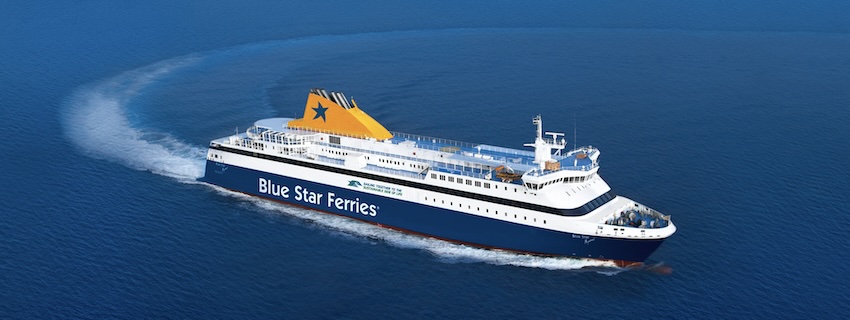 |
Getting to and Around FourniFourni is only accessible by boat. There are three Blue Star ferries a week to and from Piraeus (a seven hour journey) during high season, which also stop in Samos and Ikaria. Daily boats from Agias Kyrikos on Ikaria run daily in the summer. Fourni is also served by Dodekanisos Seaways which extends its service from Samos and Patmos in the summer. All tickets for the ferries can be purchased from the helpful travel office on the main street, which also provides information about boats to Thymaina, and other excursions around the island. In season, there are two ferries that make the 15-minutes journey to Thymaina each day; a morning milk run (with car deck), and a passenger ferry - there and back - in the afternoon. For land transport, inquire at Escape Car & Bike Rental or Koursaros Rent-A-Car. At Escape, you can expect excellent service, vehicles and prices when you rent a car, scooter or quad (hint: Fourni, with its roller-coaster hills and knock-out views of the sea, is begging you to try it on a scooter!). |
Accommodation on FourniMost hotels on Fourni are budget friendly, two-star, family-owned and operated establishments. Larger hotels with attached cafe/bars tend to be on the main harbourside road or with sea view, while smaller pensions are snug within the village (to book the smaller pensions, you can either go directly to their websites, or just show up at their door). Here’s a brief description of what is available. Clearly visible from the ferry, Patras Apartments has a range of accommodation. One part consists of a creative tiered complex of detached apartments with kitchens and cozy outdoor nooks, and the other, an aggregate of buildings housing a variety of single rooms with kitchenettes and balconies, with the atmospheric Archontiko Cafe situated streetside. Budget prices, unstinting hospitality. Also on the water front are Limenaki Studios and Studios Nektaria On the Beach. For an air-bnb style holiday home see Bazakos Luxury Seafront Apartment |
|
|
Cafes, Restaurants, TavernaDuring high season, you will find a generous selection of beverage and meal choices on Fourni. For your morning pastry, and coffee – be it Greek, filtered or frothed – you can begin up in the town square, at Drosia Café, where nursing a drink under the large plane tree is just an excuse for unabashed people watching, or venture down mulberry lane to Maistrali Café/Taverna to sample one of their homemade sweet or savory pies (reputedly the best in Greece!), or snag a chartreuse chair at the colourful and welcoming Sto Stoki Tou Skou Café. If you prefer a harbour view while coddling your coffee or afternoon refreshment, the leafy Archontika Café has a table reserved for you for as long as you need. As Fourni has the largest working fishing fleet in the Aegean, lunch and dinner menus on the island will feature the catch-of-the-day, typically either seabream, red porgy or dusty grouper. Specializing in freshly caught fish, seafood and the island specialty – lobster spaghetti – are a string of restaurants on the harbour side road: Niko Tzeni Taverna, Meltimi tou Mitika, O Miltos Restaurant and Seafoods, and Dephinakia. Alternatives to fish – grilled and barbecued souvlaki, lamb, and a variety of vegetarian mezes - can be found at Kastaplias, The Girls and Fouro-Akpoyali on the waterfront. On mulberry lane and in the town square, Le Petit Pardal, and Ksenixtis Platonas and Kali Kardia Taverna offer streetside seats, uniquely flavoured grilled meats and house specialties, reasonable prices, and exceptional service. Hovering over town is the new hill-top Mylos Café/Bar, its stylishly refurbished windmill and spot-lit terrace making it a beacon for boaters and primo spot for a sunset cocktail or leisurely night-cap. Outside of Fourni Town, the options are more limited, but quality of food and service uniformly outstanding. On the way to Kampi, the new Milos Café Bar in the other refurbished windmill on the island, offers coffee, snacks and light lunches and commanding views of Kampi bay, Fourni harbour, and Ikaria in the distance. On Kampi beach, the Kampi Beach Bar ensures that patrons of the only beach chairs on the island are kept hydrated and fortified. Two other beaches – Kamari, and the one below Chrysomilia - make the precipitous descents down to them all worthwhile. Beach-rustic Taverna Almyra and Fratzesca’s Taverna are the real thing, with plates of goodness from the sea and garden. Equally seductive is O Kottaras Taverna situated at the far end of Kerameidou beach on Thymaina A Greek salad, basket of kalamari and a bottle of retsina, lapping waves at your feet, and ready service will make an afternoon ‘marooned’ on the island across from the island pretty close to perfect. |
|
|
Shopping and Other ServicesA number of shops on mulberry lane will slake your thirst for tourist wares and local products, but most intriguing is Hecho en Mano, which features artisan products all made from beachcombing expeditions on Fourni. Maria, the creator and owner, will be happy to give the history of any piece that catches your eye. Always a stand-out in Greece, the local bakeries, like Artopoieio, will keep you supplied with tiropita, village bread and the like. For basic amenities, like chargers for your phone, bananas, suntan cream, and cash, you can count on Fourni having the usual collection of mini-markets, greengrocers, pharmacy and bank as well as a small medical centre. And given that you’ve probably fallen in love with Fourni by now, you’ll want to visit the town museum where lovingly-cared-for exhibits humbly pay tribute to Fourni’s past. |
|
|
|
Written by J. Kathleen Thompson, a freelance writer and incurable enthusiast for adventure, music, and liberal amounts of Greek sunshine. When not on a bike or boat in the Aegean, she calls Canada home. Visit her blog at justgojo.com |
 Use Ferryhopper to find all direct and indirect ferry routes for the islands of Greece, Spain, Italy &
Turkey, compare ferry companies & prices, and book cheap ferry tickets with no hidden fees in one go!
Use Ferryhopper to find all direct and indirect ferry routes for the islands of Greece, Spain, Italy &
Turkey, compare ferry companies & prices, and book cheap ferry tickets with no hidden fees in one go!
Join Matt Barrett's Greece Travel Guides Group on Facebook for comments, photos and other fun stuff. If you enjoy this website please share it with your friends on Facebook. If you are appreciative of all the free information you get on my websites you can send a donation through Paypal or you can use Venmo
